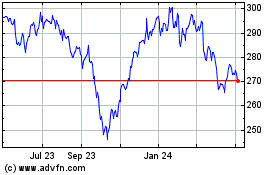McDonald's Table Service: Fast Food Redefined
November 18 2016 - 10:40AM
Dow Jones News
More McDonald's Corp. customers across the U.S. will be able to
choose table service inside restaurants, in an attempt to provide
something beyond what a traditional fast-food chain offers.
It is part of an effort central to revive the burger giant's
sales, which have flagged in recent quarters. Franchisees and
analysts have been wondering what else McDonald's would do to drive
interest in a brand that has been struggling to re-establish its
relevancy in a market where consumers have more choices than ever
to get food, including burgers.
The company that derives nearly 70% of its sales from the
drive-through is hoping changes to the restaurants themselves will
help lift sales, according to McDonald's USA President Chris
Kempczinski.
Test runs at more than 500 restaurants in Southern California,
New York and Florida showed an increase in foot traffic and
contributed to a mid-single-digit percentage increase in restaurant
sales, lifting the $5 to $6 average check by $1, on average.
Customer satisfaction scores also have increased at those test
stores, executives said, because families, in particular,
appreciate having their food brought to them.
McDonald's Chief Executive Steve Easterbrook, speaking at a
McDonald's in New York's Tribeca neighborhood on Thursday, said the
company has long expected customers to adapt to its business model
of ordering at the counter and then waiting to collect their own
food. Now, he said, "we're adapting our business around
customers."
Analysts say there is little downside, since the cost is
relatively low, but there are risks. If the restaurants aren't able
to keep their stores clean and offer friendly service—two
challenges that have plagued the company—having table service isn't
going to enhance the experience, said Darren Tristano, vice
president at restaurant consulting firm Technomic Inc.
In addition to table service, the company is also installing
free-standing kiosks inside the restaurants, which have proven
successful in overseas markets including the U.K., France and
Australia, according to the company, which said people tend to
order more food when they don't feel pressured to order at the
counter. Customers can pay for their food at the kiosk and indicate
whether they want table service.
Installing the kiosks themselves and rearranging the flow of the
restaurant can range from about $28,000 to $60,000, depending on
the volume of business the restaurant does. They will only be
installed in restaurants that are remodeled to be more modern.
Starting early next year, the kiosks and table service will be
rolled out in Boston, Chicago, Seattle, San Francisco and
Washington, D.C., and eventually the plan is to do it
nationwide.
McDonald's said it is providing additional training to employees
who will be interacting with customers more, including greeting
them as they enter.
"The biggest risk is that traditional Boomer and GenX customers
may not give them the permission to make these changes and rebel
against them by opting to go to other competitors," Mr. Tristano
said, citing an effort by Ruby Tuesday to upgrade their menus and
interiors. "Their customers saw them as a traditional casual dining
chain that served food at the $14 check average and the new
contemporary interiors failed to attract more affluent consumers
and scared away their loyal customers."
Write to Julie Jargon at julie.jargon@wsj.com
(END) Dow Jones Newswires
November 18, 2016 10:25 ET (15:25 GMT)
Copyright (c) 2016 Dow Jones & Company, Inc.
McDonalds (NYSE:MCD)
Historical Stock Chart
From Mar 2024 to Apr 2024

McDonalds (NYSE:MCD)
Historical Stock Chart
From Apr 2023 to Apr 2024
